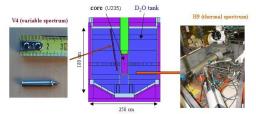
Scheme of the ILL reactor and Mini-Inca installations. Pictures of a fission chamber (left) and the reaction chamber (right) are also shown.
Means of investigation
To conduct our studies, we have developed or adapted several experimental and analysis techniques for high neutron fluxes. First of all, two irradiation channels are used: the H9 and V4 channels. Two experimental technique are used: alpha- and gamma-spectroscopy, and fission rate measurements.
Alpha- and gamma-spectroscopy is realized thanks to “reaction chamber” which is connected to the source exchanger of the H9 beam tube. High purity Ge is used for gamma-spectroscopy and PIPIS Si detector for alpha-spectroscopy. This tool is very useful to characterise the sample before and after irradiation.
Fission rate are measured thanks to small ionisation detectors called fission chambers. These detectors are developed by Dapnia, fabricated by Photonis corporation and assembled by CEA/DEN/DER/SPEX. They are used in the V4 channel to monitor online the evolution of irradiated sample. In this channel it is also possible to irradiate samples and to analyse them off-line by mass spectrometry (CEA/DEN/DER/LANIE).
These different experimental techniques are completed by analysis tools which allow to simulate the evolution of the very complex transmutation chains and to propagate the different sources of errors.
Technical description
Irradiation channels
The V4 channel is very close to the fuel element with its lower part located at 10 cm from the fuel in the median plane. It is an asset of the experiment because it provides fluxes for which the intensity values are close to those that will be found in future generation IV reactors (1015 n/cm2/s). This channel is fully dedicated and managed by the Mini-INCA experiment. The H9 channel is shared with the Lohengrin mass spectrometer and gives access to lower neutron fluxes (6 1014 n/cm2/s) but more thermalised (98 % of neutrons have energy less than 1eV).
Reaction chamber:
The reaction chamber consists of a coaxial germanium detector with a "reset transistor" preamplifier and 100 micrometer thick "pips" silicon from Cambera industry. Both sensors are mounted on mobile carts to modulate the counting rate in the detectors. The whole chamber is automated to reduce human intervention in the transfer of irradiated samples.
Fission chambers:
Fission chambers are tiny cylindrical ionization chambers which contain in their central part a deposit which can be either a fissile or fertile sample. They measure 4 mm in diameter to about 2 to 3 cm long. For transmutation studies we have adapted these detectors under the form of three chambers, electrically independent but sharing the same gas. This concept is called «triple deposit» and presents the advantage of measuring the rate of fission according to a reference (235U fission) and the background noise in a small footprint.
The great specificity is the high flux of neutrons (around 1015 n/cm2/s).
Avantages:
- small sample masses;
- possibility to form and to study on-line short-life isotopes (from few minutes to few days) and very radioactives.
Problems:
- need special developments for the instrumentation and analysis tools.


